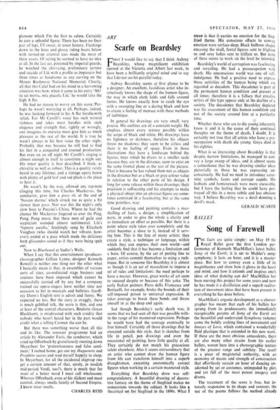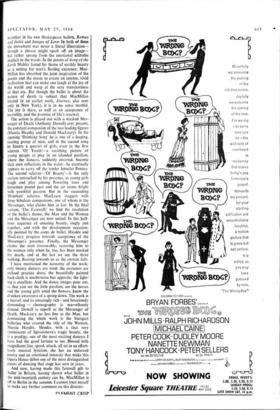BALLET
Song of Farewell
rrHE facts are quite simple: on May 19 the I Royal Ballet gave the first London per- formance of Kenneth MacMillan's latest ballet, Song of the Earth; it is set to Mahler's song- symphony; it lasts an hour, and it is a master- piece. But how to convey even a little of its magnificence and show how it glows in the heart and mind, and how it extends and inspires one's ideas of what dancing can do? MacMillan has been nursing this project for some years and now he has made it a distillation and a superb realisa- tion of movement ideas that have been present in everything he has done before.
MacMillan's organic development as a choreo- grapher has meant that each of his ballets has sprung from its predecessors; the immediately recognisable parents of Song of the Earth are the beautiful and underrated Symphony (whence come the boldly arching lines of movement) and Images of Love, which contained a wonderfully fluid plastique that is extended in this new work.
If these are the most obvious antecedents, there are also many other strains from his earlier ballets, woven here into a choreographic texture of the greatest range and subtlety. The result is a piece of magisterial authority, with an economy of means and strength of construction that effortlessly sustain an hour of dancing un- adorned by set or costumes, unimpeded by plot, and yet full of the most potent imagery and drama.
• The treatment of the score is free, but in- tensely responsive to its shape and content; the use of the poems follows the method already manifest in his two Shakespeare ballets, Romeo and Juliet and Images of Love. In both of these the movement was never a literal illustration— though a phrase might spark off an image— but rather sprang from the emotional attitudes implicit in the words. In the poems of Song of the Earth Mahler found his theme of earthly beauty as a setting for man's fleeting existence; Mac- Millan has absorbed the joint inspiration of the poems and the music to create an intense, vivid realisation that can make one laugh at the joy of the world and weep at the very transitoriness of that joy. But though the ballet is about the nature of death (a subject that MacMillan treated in an earlier work, Journey, alas seen only in New York), it is in no sense morbid. The joy is there, as well as an acceptance of mortality, and the promise of life's renewal.
The action is played out with a masked Mes- senger of Death (Anthony Dowell) ever present, the constant companion of the two leading figures (Marcia Haydee and Donald MacLeary). In the opening 'Drinking Song' he is one of a leaping, soaring group of men, and in the second song he haunts a quartet of girls, even in the first scherzo 'Of Youth'—a ravishing picture of young people at play in an islanded pavilion, where the dancers, suddenly inverted, become their own reflections in the water—he eventually appears to carry off the tender Jennifer Penney. The second scherzo—'Of Beauty'—is the only section untouched by his presence, as young girls laugh and play among flowering trees and horsemen pound past and the air seems bright with youthful passion. But in the succeeding 'Drunken' scherzo, MacLeary staggers with three bibulous companions, one of whom is the Messenger, who claims him at last. In the- final section, `The Farewell,' we find the resolution of the ballet's theme; the Man and the Woman and the Messenger are now united. In this half- hour sequence of amazing beauty, singly and together, and with the development occasion- ally pointed by the corps de ballet, Haydee and MacLeary progress towards acceptance of the Messenger's presence. Finally, the Messenger claims the man irrevocably, restoring him to the woman only when he, too, has been masked for death, and at the last we see the three walking, floating towards us as the curtain falls.
I have mentioned the economy of the work; only twenty dancers are used; the costumes are stylised practice dress, the beautifully painted back-cloth is unobtrusive but apposite; the light; ing is excellent. And the dance images pour out, so that you see the little pavilion, see the horses and the young girls amid the flowers, know the drunken awareness of a spring dawn. The work is a marvel, and its amazingly rich—and ferociously demanding — choreography is marvellously danced. Dowell is superb as the Messenger of Death, MacLeary no less fine as the Man, but dominating the whole work is the Stuttgart ballerina who created the role of the Woman, Marcia Haydee. Slender, with a face very reminiscent of Spessivtseva's tragic beauty, she is a prodigy, one of the most exciting dancers I have had the good fortune to see. Blessed with magnificent line, speed, attack, all set in an effort- lessly musical lyricism, she has an unforced poetry and an emotional intensity that make this Opera House debut one of the most distinguished pieces of dancing that stage has seen in years.
And now, having made this farewell gift to ballet in Britain, having shown what ballet in the mid-twentieth century can be, MacMillan is off to Berlin in the autumn. I cannot trust myself to make any further comment on this disaster.
RMENT CRISP



































 Previous page
Previous page